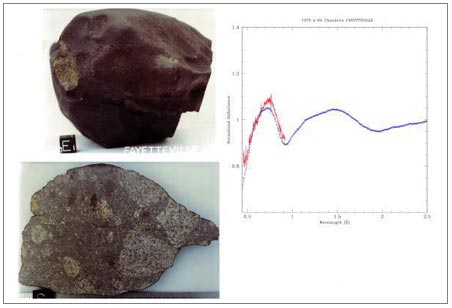Discover the origin of the most common meteorite
When observed with the GEMINI telescope, two Brazilian and American astronomers first discovered that small planets resemble 'ordinary particle meteorites' , the most common meteorite found on Earth. Land.
Until now, astronomers have not yet recognized their planetary origin, but the main reason is that geological processes appear after the meteorite separates from the parent planet.
Astronomy & Astrophysics published the first discovery by two astronomers, T. Mothé-Diniz (Brazil) and D. Nesvorrný (USA), about small planets with a similar spectrum to ordinary particle meteorites - objects meteorite is similar to the composition of the Sun. Most of the meteorites we collect on Earth come from the main planetary belt between Mars and Jupiter (1) . They separated from the mother planet after colliding, entering another orbit, eventually falling to Earth. Meteors are the main tool to learn about the history of the solar system because their composition is a record of geological processes that happened when they were attached to the parent planet.
Our fundamental difficulty is that we do not know exactly where most meteorite samples come from in the planetary belt. For many years, astronomers were unable to discover the parent planet of the most common meteorite - the meteorite particle accounted for 75% of the collected meteorites.

Right: Compare the spectrum of the small planet (1270) Datura with the spectrum of Fayatteville's meteorite.Left: Photo of the Fayetteville meteorite.(Photo: Arkansas Space and Planetary Science Center, University of Arkansas).
To search for the asteroid's original planets, astronomers must compare the spectrum of meteorite specimens with samples from the planets. This is a difficult task because the meteorites and their parent planets undergo different processes after the meteorite is separated. Specifically, the planet's surface is transformed by a process called 'space weather' , created by microscopic meteorites and solar wind, gradually transforming the planet's surface spectrum. The planet's spectral properties become different from meteorites, which makes it difficult to recognize the asteroid's mother planet.
Collision is the main process that affects the planet. Under the influence of the strong impact, the planet may burst, its pieces follow the original orbit of the planet. These fragments constitute a population that astronomers call 'planetary families' . Until recently, most known planetary families were very old (they were formed from 100 million to 1 billion years ago). Of course, it is difficult to detect young planet families because the planets are very close to each other (2) . In 2006, four new and very young planetary families were identified, ranging in age from 50,000 to 600,000 years. The population of these fragments is often less affected by 'space weather' after the first fracture compared to older planet families. Mothé-Diniz and Nesvorný observed the planets using the GEMINI telescope (one in Hawaii, one in Chile), and obtained a visible spectrum. They compared the planetary spectra to the spectrum of the conventional particle meteorite (Fayetteville meteorite (3)) and found many similarities.
This is the first study to see a match between the most common meteorite and planets in the main ring. It also attests to the role of space weather in changing the surface of the planet. Recognizing the asteroid's mother planet is the only tool that can study the history of the solar system since it can be used to determine the time of geological events (meteorite analysis by date-determination techniques ) and their position in the solar system (from the position of the parent planet).
1. There are a few exceptions, including the famous meteorite that originates from Mars
2. After the original planet is broken, the debris moves away from each other. The further the collision occurred, the farther the distance between the debris.
3. Meteors are named after the locations they were collected. The Fayetteville meteorite falls near Fayetteville, Arkansas on December 26, 1934.
Refer
Mothé-Diniz et al.Visible spectroscopy of extremely young families.Astronomy and Astrophysics, 2008;486 (2): L9 DOI: 10.1051 / 0004-6361: 200809934
- Determine the origin of Russian meteorites
- What is Chondrit meteorite?
- Learn the origin of the earth through meteorite research
- Discover the origin of cosmic dust on Earth
- Discover the mysterious diamond falling from the sky
- The origin and name of meteorite
- Discover large meteorite in Antarctica
- Find the largest meteorite pieces in Russia
- Flocking to find meteorite fragments in Russia
- The meteorite explosions
- Poland found the largest meteorite block in Eastern Europe
- 5 most common myths about the universe
 Van Allen's belt and evidence that the Apollo 11 mission to the Moon was myth
Van Allen's belt and evidence that the Apollo 11 mission to the Moon was myth The levels of civilization in the universe (Kardashev scale)
The levels of civilization in the universe (Kardashev scale) Today Mars, the sun and the Earth are aligned
Today Mars, the sun and the Earth are aligned The Amazon owner announced a secret plan to build a space base for thousands of people
The Amazon owner announced a secret plan to build a space base for thousands of people